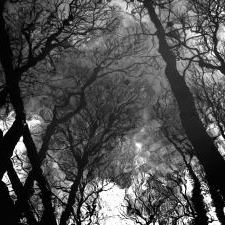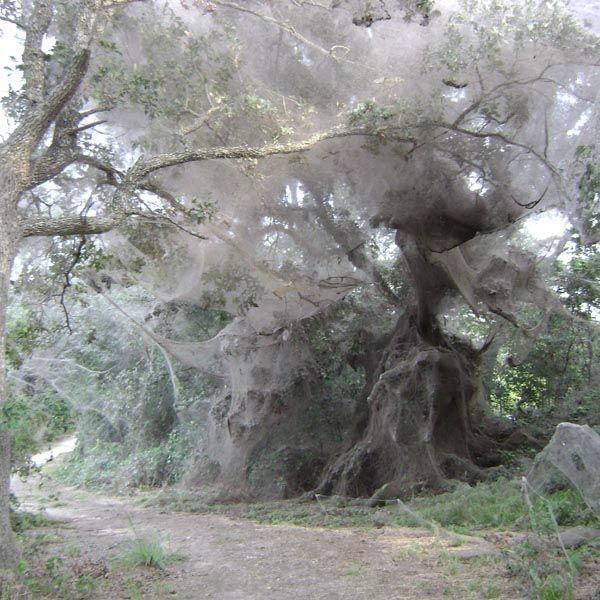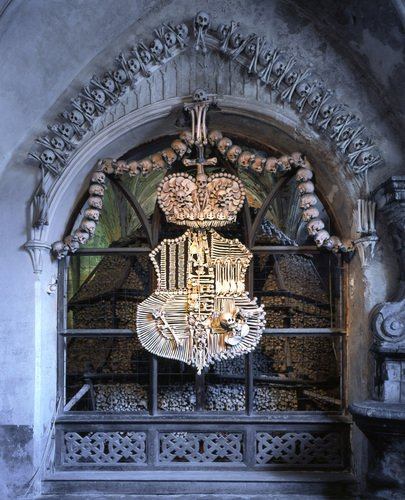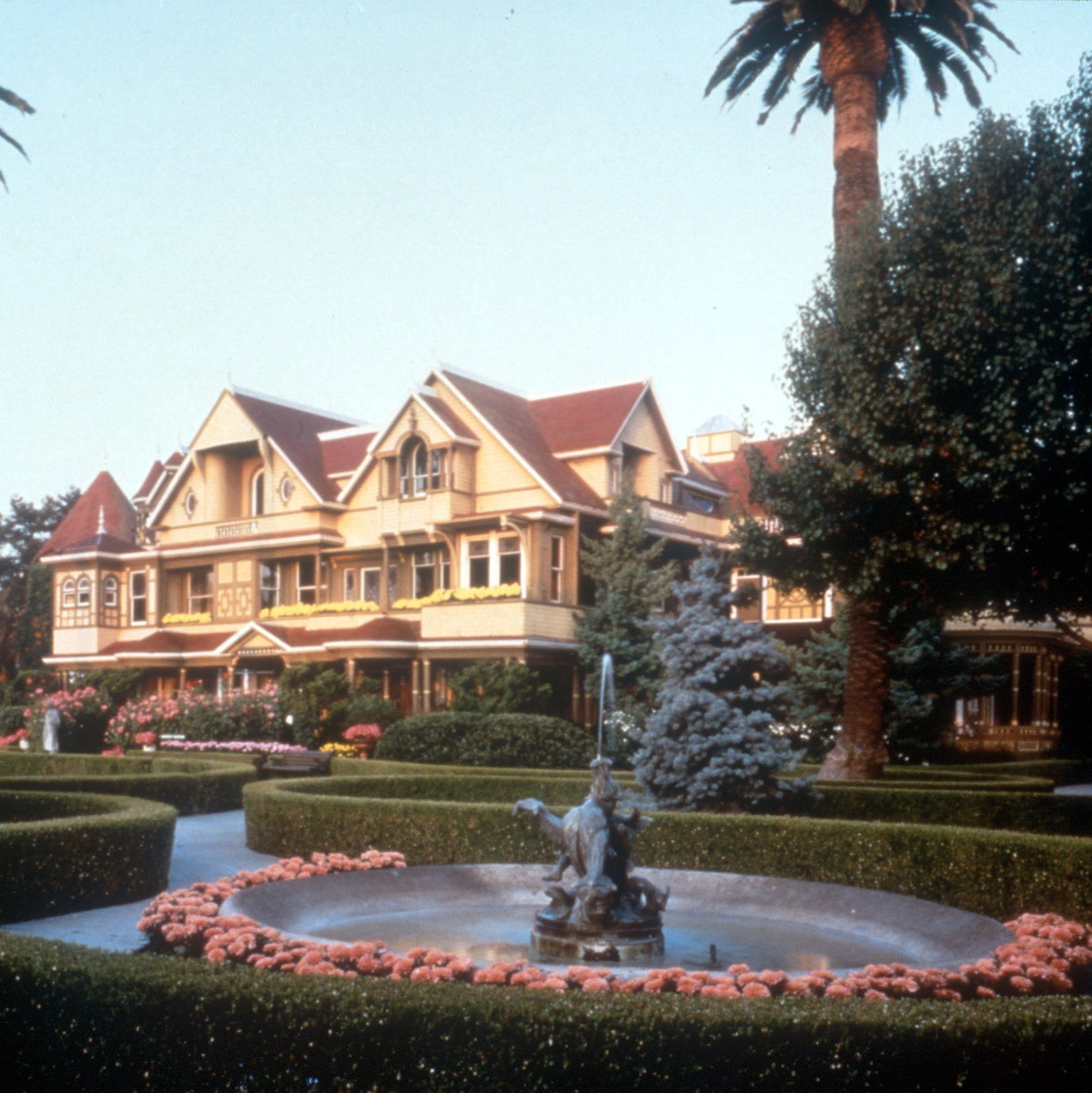 Autumn conjures images of leaf-raking, harvest cornucopias, and pumpkin carving, but many of us also enjoy the thrill of the spooky— and sometimes ghooooulish—ambiance Halloween invokes.
Autumn conjures images of leaf-raking, harvest cornucopias, and pumpkin carving, but many of us also enjoy the thrill of the spooky— and sometimes ghooooulish—ambiance Halloween invokes.
Whether spider webs, bones, death, ghosts, devils, or medieval punishments frighten you with excitement, here are some places to visit that are sure to give you the heebie-jeebies.
Web-tacular!
Do you remember being young and fascinated with a single, intricate spider web?
Well, at the Lake Tawakoni State Park in Texas (50 miles east of Dallas), you can creep through not one, but a forest of trees veiled with webs (see image at right, courtesy of Donna Garde). The web was discovered on August 6, 2007 by a park ranger who was tending to one of the park’s nature trails.
 Park officials estimated that the original web draped over and in between 100 yards or six large Post Oak trees that surround a small pond.
Park officials estimated that the original web draped over and in between 100 yards or six large Post Oak trees that surround a small pond.
According to Allen Dean, a spider expert at Texas A&M University, similar webs have occurred in the past, but not to this extent (although Texas’ land is 90 percent or more privately owned, so other webs could exist elsewhere). This year particularly was unusual because Texas received lots of rain, therefore providing the creepy-crawly critters with a large food supply of mosquitoes and midges, so it was beneficial for them to combine web “forces” to catch a larger amount of prey. Even Dean referred to the webs as “rather spooky, kind of like Halloween.”
Donna Garde, the park’s superintendent who is ecstatic about the webs, says the various spiders are “tolerating each other being in close proximity because there is such an abundance of food; they don’t need to compete.” Twelve different species—but mainly the Long-jawed Orb Weaver (tetregnatha guatamalensis)—are responsible for this horribly magnificent attraction.
Normally, the Long-jawed Orb Weaver is “often defending their web aggressively and sometimes killing and eating another spider who invades it. But with this occurrence, I counted 32 spiders within a roughly one cubic foot area!”
Of course, she and other park officials have become protective over the webs, fending off those with maladroit manners or little boys who crave the moment when they can push their younger sisters into the icky-sticky webs. The webs have been ripped apart about six or seven times by wind, but the spiders persevere. The webs are expected to last until the next hard freeze hits the area, and experts are curious to see if they will return next spring. 800-792-1112, Lake Tawakoni State Park Web site.
Ghastly Church o’ Bones
 Most churches offer a heavenly sanctuary for the masses, but once you walk into the Sedlec Ossuary chapel, also known as the Chapel of All Saints or Bone Church, and catch a glimpse of its chandelier, you’re more likely to feel more nauseated than enlightened.
Most churches offer a heavenly sanctuary for the masses, but once you walk into the Sedlec Ossuary chapel, also known as the Chapel of All Saints or Bone Church, and catch a glimpse of its chandelier, you’re more likely to feel more nauseated than enlightened.
Located in Sedlec, Czech Republic, this church’s chandelier (image courtesy of Czech Tourism) is not constructed of dainty crystals but of freakish phalanges and other bony accoutrement—at least one of each bone in the human body. Skeletal aesthetics decorate almost the entirety of the chapel’s interior.
Built around the year 1400, the chapel rests on the cemetery of the Cistercians monastery, a cemetery used for burying those killed in the Black Death during the 14th century. According to legend, a half-blind monk had the task of exhuming the skeletons and stacking the remains inside the church.
 Much later in 1870, the Schwarzenberg family commissioned František Rint, a woodcarver, to bring order to the heaps. He tucked four large mounds of bones into each corner of the chapel, attached garlands of skulls to the chandelier, and fashioned a large Schwarzenberg coat-of-arms, two monstrances—vessels used to display the consecrated Eucharistic Host—and beside the main altar “signed” his name in bones over a bench. An estimated 40,000 bones appoint this “chest” of human skeletal treasures. (011 420) 327 561 143, www.kostnice.cz
Much later in 1870, the Schwarzenberg family commissioned František Rint, a woodcarver, to bring order to the heaps. He tucked four large mounds of bones into each corner of the chapel, attached garlands of skulls to the chandelier, and fashioned a large Schwarzenberg coat-of-arms, two monstrances—vessels used to display the consecrated Eucharistic Host—and beside the main altar “signed” his name in bones over a bench. An estimated 40,000 bones appoint this “chest” of human skeletal treasures. (011 420) 327 561 143, www.kostnice.cz
Funeral Fantasia
If bones don’t quite suit your fancy, then jump into a hearse and visit the National Museum of Funeral History in Houston, Texas. It has a 1990s Casket Factory exhibit designed from original blueprints and design plans, and showcases artifacts that have been in use until a year ago. Here, you will learn about the design and construction used for casket-making.
This museum also features a unique Fantasy Coffins exhibit, which features coffins that have been oddly carved into animals or objects, such as a chicken, lobster, leopard, Mercedes Benz, or KLM Airliner. The Ghanaian sculptor Kane (pronounced “Kahnnee”) Quaye began creating “Fantasy Coffins” over 30 years ago when his uncle requested a special coffin, and his coffins have been commissioned by people worldwide. Tickets cost $6 for adults and $3 for children under 12. 281-876-3063, www.nmfh.org
If one funeral museum doesn’t spook your fancy, try another. The Funeral Museum in Springfield, Illinois displays horse-drawn and motorized hearses and a chronology of caskets and coffins. Rare today, people throughout history wore mourning attire.
In the 1700s, women bejeweled themselves with modest bereavements, such as a small brooch with pearls dotting its circumference. At the height of the Romantic era, mourning jewelry was more ornately appointed. When a loved one passed, hair was removed from the body, woven, and safely kept in lockets or encased in glass pendants. The museum also has a collection of rare books on embalming, dating back to the early 16th century. (217) 544-3480, www.funeralmuseum.org
Ghostly Maze of Rooms
For a bizarre labyrinth and ghostly hauntings, visit the Winchester Mystery House in San Jose, California. In 1884, the wealthy widow named Sarah L. Winchester, the Winchester Rifle heiress of more than $20 million, began a construction project so grandiose that it lasted 38 years, until she died.
 This Victorian home has 160 rooms, 1,257 window frames, 476 doorways, 47 fireplaces, and 40 staircases. No blueprints exist of this house, but Mrs. Winchester did sketch out individual rooms on paper and even tablecloths.
This Victorian home has 160 rooms, 1,257 window frames, 476 doorways, 47 fireplaces, and 40 staircases. No blueprints exist of this house, but Mrs. Winchester did sketch out individual rooms on paper and even tablecloths.
Legend has it that Sarah believed that those who were killed by Winchester rifles haunted her house. Soon after the deaths of her daughter Annie in 1886 and her husband in 1881, she supposedly consulted a medium who warned her that the Winchester family was cursed because so many had died as a result of the rifles. The medium told her she must move west and build a house for herself and the spirits and that if she stopped building, she would die.
Many aspects of the houses architecture, however, seem to have no obvious use. Stairways lead to ceilings and doors lead to brick walls. Motifs that Mrs. Winchester considered lucky, such as spider webs and the number 13, appear throughout the house. For example, a Tiffany window has spider web-patterned bejeweled with 13 colored stones. The house also has 13 hooks in the séance room, 13 bathrooms, windows and doors in the old sewing room, 13 palms lining the main driveway, and chandeliers with 13 lights.
The house is open to the public, and on Halloween and every Friday the 13th, they offer 65-minute flashlight tours. Flashlight tours cost $39, and the mansion tour is $23.95 for adults and $17.95 for children 6-12. 408-247-2101, www.winchestermysteryhouse.com.
Torturous Delights
If you savor gory slasher movies, welcome to the Medieval Crime Museum in Rothenburg, Germany! Commonly referred to as the “torture museum,” the museum is considered to be a very important museum of legal history in the country and in Europe. Here, you can view old legal documents, illustrated legal guides, German codes of law, and records, including court proceedings, property transfers, punishments, due dates, and liability.
Of course, in the medieval times, those who were found guilty of a crime received punishment of the most gruesome kind. Here you can view original torture devices. Finger screws were used to make people tell the truth. A “drunk barrel” was worn by drunkards, and two women who bickered with one another were forced to wear a neck violin, which locked the two women together. If you would like a guided tour, make sure to call in advance. Tickets cost about $5. (00 49 98 61) 53 59, https://www.kriminalmuseum.rothenburg.de (English-language page).
By Monique-Marie DeJong for PeterGreenberg.com.
Want more ideas for family fun that’s a bit less scary? Check out Scenic Trains for Kids or How to Beat the Crowds at Theme Parks.
Popular Articles By Monique-Marie DeJong:












